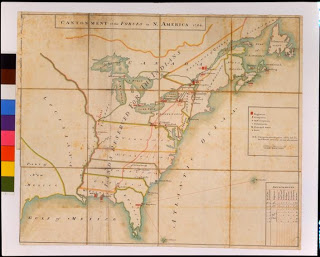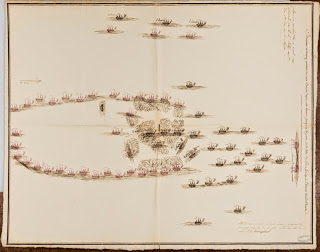The William L. Clements Library is pleased to announce its participation in a new exhibition, We Are One: Mapping America’s Road from Revolution to Independence, opening May 2, 2015, at the Boston Public Library’s Norman B. Leventhal Map Center. Featuring cartographic and geographic representations of how America transformed from British colonies to an independent nation, We Are One presents a unique opportunity to explore the Revolutionary era in all its drama. The Clements Library is among 20 institutions and private collectors that together have contributed some 60 maps and 40 prints, paintings, and objects to be on view at the Boston Public Library from May through November 2015, before the exhibit travels to Colonial Williamsburg in 2016 and the New-York Historical Society in 2017.
Cartographic materials can tell compelling narratives, and the three manuscript maps that the Clements has loaned to the exhibit certainly speak volumes. The first item, a colored map entitled “Cantonment of the forces in N. America, 1766,” shows the distribution of British forces in the North American colonies.
 |
| Cantonment of the forces in N. America, 1766.” From the William Petty, 1st Marquis of Lansdowne, 2nd Earl of Shelburne Papers, William L. Clements Library. |
Sent by Thomas Gage, British Commander-in-Chief in North America, to William Petty-Fitzmaurice, the Secretary of State for the Southern Department, the map and its accompanying documentation tell a tale of shifting military concerns. Three years after the conclusion of the French and Indian War, this manuscript map shows that the bulk of the British forces still centered around regions formerly controlled by France and Spain, shadowing the threats of recent contests. Gage warned, however, of the increasingly “disturbed state” of the colonies, “and the Decision of the Parliament respecting the Stamp Act impatiently waited for; not without denouncing Vengeance in Case the Decision should not be agreeable to their Expectations.” This map vividly illustrates the arrangement of British forces in North America following the French and Indian War and as political unrest occasioned by the Stamp Act continued to swell.
The two other maps on loan from the Clements Library were created by Alexandre d’Ethy, a French commander that fought in the Battle of the Saintes in April 1782, an Anglo-French naval engagement that took place in the passage between Dominica and Guadeloupe. The definitive British victory ensured their continued control of their West Indian colonies and bolstered their reputation of naval dominance. The Clements holds a series of eight manuscript maps documenting the shifting course of the Battle of the Saintes, believed to have been used in the 1784 trial of Admiral François Joseph Paul de Grasse to determine blame for the resounding French defeat.

 |
| Plan du Combat du 12 Avril 1782 présenté par le chr. Dethy capne. du vass. de roy le Citoyen: Neuvième et dernière position des deux armées…” From the Charles-Eugène-Gabriel Castries Papers, William L. Clements Library. The other d’Ethy map in the exhibit features the two fleets’ third position. |
The maps’ incredible detail, then, highlights the nuances of Revolutionary naval battles as well as their lasting significance.
We Are One: Mapping America’s Road from Revolution to Independence promises to be an extraordinary exhibit, bringing together invaluable maps, prints, and artifacts from world-renowned collectors and institutions to provide new insights into the American Revolution. If you are unable to make the trip to the East Coast while the exhibit is on display, a number of the items will be available online through the Norman B. Leventhal Map Center’s American Revolution Portal [http://maps.bpl.org/highlights/ar/american-revolutionary-war-era], including the Clements Library’s contributions. And, of course, while these three maps are on loan the rest of the William L. Clements Library’s extensive map collection remains open to researchers, with a wonderful array of Revolutionary-era maps available to be studied and cherished year-round.
